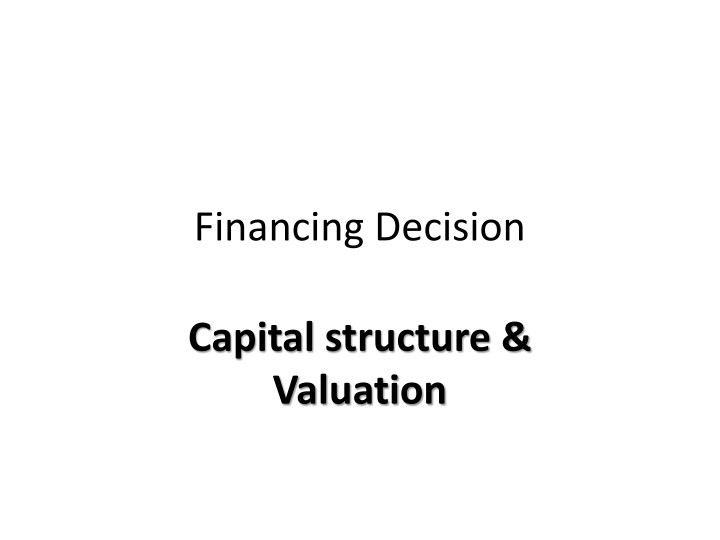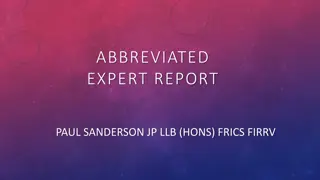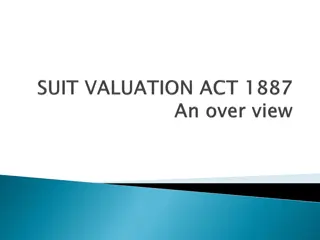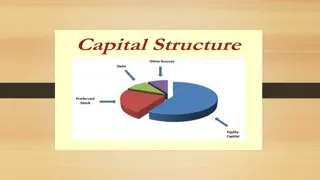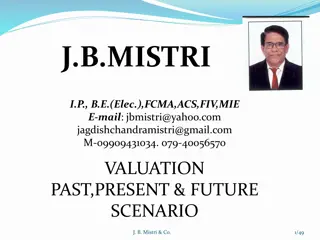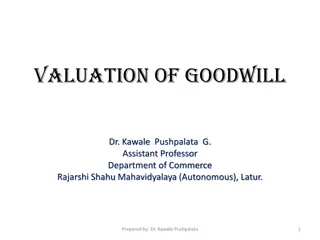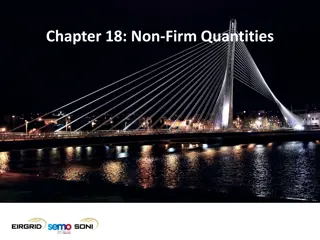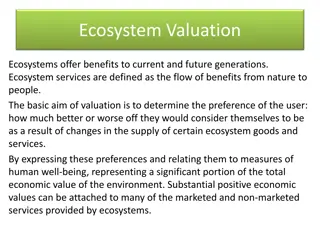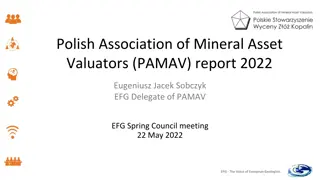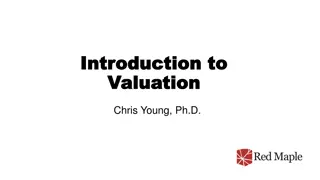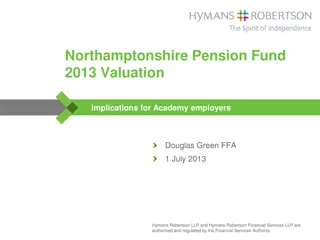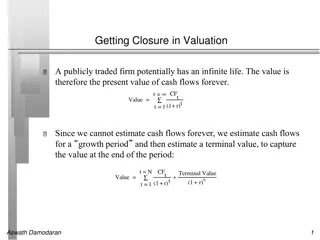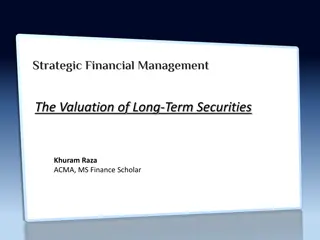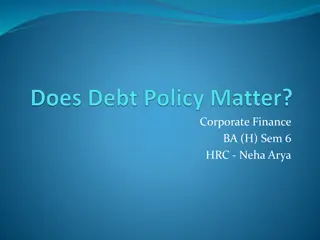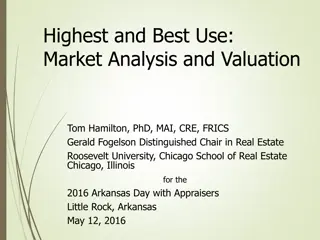Theories of Capital Structure and Firm Valuation
The impact of financing decisions on capital structure and valuation using the Net Income Approach and Modigliani-Miller theory. Understand the relationship between debt and equity, the cost of capital, and optimal capital structure for maximizing firm value.
Download Presentation

Please find below an Image/Link to download the presentation.
The content on the website is provided AS IS for your information and personal use only. It may not be sold, licensed, or shared on other websites without obtaining consent from the author.If you encounter any issues during the download, it is possible that the publisher has removed the file from their server.
You are allowed to download the files provided on this website for personal or commercial use, subject to the condition that they are used lawfully. All files are the property of their respective owners.
The content on the website is provided AS IS for your information and personal use only. It may not be sold, licensed, or shared on other websites without obtaining consent from the author.
E N D
Presentation Transcript
Financing Decision Capital structure & Valuation
Theories of capital structure Two school of thoughts: Financing decision affects the valuation Net Income Approach(NI) Financing decision does not affect the valuation Net Operting Income (NOI) Approach Modigilliani Miller (MM) Approach Traditional approach Value of firm(V) = EBIT/Ko
Assumptions Two sources : debt & equity No taxes 100% dividend pay-out ratio No retained earnings EBIT Debt-holders(interest) Equity holders(dividend) Debt(D) = Interst/Kd Equity (E) = Earnings for equity/Ke, Ke= EPS/MPS MPS = EPS/ Ke= Value of equity(E)=Earnings for equity/ Ke Value of firm(V) = EBIT/Ko Investment decision is constant
Net Income Approach(NI) (David Durand) Two sources : debt & equity No taxes 100% dividend pay-out ratio No retained earnings Investment decision is constant Debt is cheaper as compare to equity Increasing debt in capital structure will not change the risk perception of equity shareholders( cost of equity will remain constant)
Increase the proportion of debt will reduce the overall cost of capital and therefore, value of firm will increase EBIT 10,00,000 10,00,000 10,00,000 Interest@10% 5,00,000 7,00,000 3,00,000 Earnings for equity 5,00,000 3,00,000 7,00,000 Equity capitalisation rate 12.5% 12.5% 12.5% Value of equity(E) 40,00,000 24,00,000 56,00,000 Value of Debt(D) 50,00,000 70,00,000 30,00,000 Value of firm(V) 90,00,000 94,00,000 86,00,000 KO = EBIT/V 11.11% 10.64% 11.63%
Diagram of NI Ke,Kd,Ko Ke Kd Ko Leverage(D/V)
Optimum capital structure YES 100% Debt in its capital structure Overall cost of capital will be minimum Value of firm will be maximum
Net Operating Income (NOI) Approach (David Durand) Two sources : debt & equity No taxes 100% dividend pay-out ratio No retained earnings Investment decision is constant Cost of debt will be constant Overall cost of capital will remain constant Increasing debt in capital structure will change the risk perception of equity shareholders( cost of equity will also change)
Increase in cost of equity in such a way that it will set-off the benefit arising due to increase in debt in capital structure 80*5 + 100*5/10 = 90/ per kg 80*8 + x *2/10 = 90/ per kg X = 130
Illustration EBIT= 20,00,000, Ko= 12.5%, Debt @10% EBIT 20,00,000 20,00,000 20,00,000 Ko .125 .125 .125 V 1,60,00,000 1,60,00,000 1,60,00,000 D 50,00,000 70,00,000 30,00,000 E 1,10,00,00 90,00,000 1,30,00,000 EBIT 20,00,000 20,00,000 20,00,000 Interest 5,00,000 7,00,000 3,00,000 Earnings Eq15,00,000 13,00,000 17,00,000 Ke .136 .1445 .131
Diagram of NOI Ke,Kd,Ko Ke Ko Kd (D/V)
Modigilliani-Miller(MM) Approach Similar to NOI Behavioural justification Arbitrage process (simultaneously buying &selling) will continue till the price of both the shares will be equal Home- made leverage & corporate leverage
Assumptions of MM Two sources : debt & equity No taxes 100% dividend pay-out ratio No retained earnings Investment decision is constant Perfect capital market No transaction cost Unlimited lending/borrowings are available to individual investors same as to institutional borrowers. Perfect substitution of Home-made leverage with corporate leverage
Propositions of MM The overall cost of capital and value of firm are independent of capital structure of the firm. The cost of equity(levered firm) is equal to the equity capitalisation rate of pure equity stream (unlevered firm) plus a premium for a financial risk. The cut off rate for investment decision is completely independent of the way it is financed.
Illustration(MM) X is having 10% holdings in L Ltd. EBIT 20,00,000 20,00,000 Debt 50,00,000 nil Kd Ke EBIT 20,00,000 20,00,000 Interest 7,00,000 nil Earnings for eq 13,00,000 20,00,000 Ke Value of eq(E) 65,00,000 1,14,28,571 Value of debt(D) 50,00,000 NIL Value of firm(V) 1,15,00,000 1,14,28,571 Levered(L) Unlevered(U) 14% nil 20% 17.5% 20% 17.5%
Selling price of 10% holdings of L Ltd = 6,50,000 To acquire 10% holdings in U Ltd = 11,42,857 Difference 4,92,857 Raise a loan of 5,00,000@14% = 11,50,000 Earnings L Ltd U Ltd Dividend 1,30,000 2,00,000 Interest nil 70,000 Net income 1,30,000 1,30,000
MM/NOI with taxes Value of levered firm(L) = Value of unlevered firm(U) +D*t(amount of debt*tax rate) Limitations: Assumption of perfect capital market is unrealistic No taxes Perfect substitution of corporate-made leverage with home- leverage
NOI Two companies are identical except that A Ltd has a debt of Rs 10,00,000 at 10% whereas B Ltd does not have debt in its capital structure. The total assets of both the companies A and B are same i.e. Rs 20,00,000 on which each company earns 20% return. Find the value of each company and overall cost of capital using NOI approach. Equity capitalisation rate for B Ltd is 15%. The tax rate is 50%.
A Ltd(L) & B Ltd(U) V(B) = E +D= EE/Ke +D =(EBIT -0) (1-t)/Ke +D = 4,00,000(.5)/ .15 +D = 13,33,333 +0 = 13,33,333 V(A) = V(B) +D*t V(A) = 13,33,333 + 10,00,000*.5 V (A)=18,33,333 Ko = Kd* Wd + Ke* We
B ltd= 15%, A Ltd=? EBIT 4,00,000 Interest 1,00,000 EBT 3,00,000 Tax 1,50,000 EAT/EE 1,50,000 V 18,33,333 D 10,00,000 E 8,33,333 Ke Kd Ko = .05*(10,00,000/18,33,333) + .18(8,33,333/18,33,333) Ko = 10.92% 18% 10(.5) = 5%
Traditional Approach Middle path Beyond a point cost of debt will also increase Initially cost of equity will be constant, but beyond a point it will start rising Overall cost of capital will decline initially but then start rising Value of firm will increase with leverage but will go down with excessive leverage
Practical problem A company with net operating earnings of Rs 3,00,000 is attempting to evaluate a number of possible capital structures, given below. Which of the capital structure will you recommend and why?
Practical problem(Traditional approach) Struct ure Debt Kd( %) Ke EBIT Interest EE E(EE/Ke) V(E+D) 1 1,00,000 10 12 3,00,000 10,000 2,90,000 24,16,667 25,16,667 2 2,00,000 10 12 3,00,000 20,000 2,80,000 23,33,333 25,33,333 3 3,00,000 10 12 3,00,000 30,000 2,70,000 22,50,000 25,50,000 4 4,00,000 10 12.5 3,00,000 40,000 2,60,000 20,80,000 24,80,000 5 5,00,000 11 13.5 3,00,000 55,000 2,45,000 18,14,814 23,14,814 6 6,00,000 12 15 3,00,000 72,000 2,28,000 15,20,000 21,20,000 7 7,00,000 14 18 3,00,000 98,000 2,02,000 11,22,222 18,22,222
Practical problems The two companies V and L belong to an equivalent risk class. These two firms are identical in every respect except that V company is unlevered while Co. L has 10% debentures of Rs 5,00,000. The other relevant data regarding their valuation and capitalisation rates are as follows: (i) An investor owns 10%uquity shares of company L. Show the arbitrage process and amount by which he could reduce his outlay through the use of leverage (ii) According to MM, when will this arbitrage process come to an end?
Problem-Solution Particulars L(Rs) V(Rs) EBIT 1,00,000 1,00,000 -Interest 50,000 - EE 50,000 1,00,000 Ke E 3,12,500 8,00,000 D 5,00,000 - V 8,12,500 8,00,000 Ko Debt-equity ratio 1.6 - .16 .125 .123 .125
10% holding of L Ltd(sell) 31,250 10% holdings of V Ltd (buy) 80,000 Raise loan @10% 50,000 Available funds 81,250 Dividend Income 5,000 10,000 Interest 5,000 Net income 5,000 5,000 L V
NI &NOI Two companies are identical in all respects except that X Ltd has a debt of Rs 5,00,000 borrowed at the rate of 12% whereas Y Ltd has no debt in its capital structure. The total assets of both the companies amount to Rs 15,00,000 on which the companies have earnings of 20%. You are required to do the following: (i) Calculate value of companies and Ko using NI approach taking Ke as 18% (ii) Calculate value of companies and Ke using NOI approach taking Ko as 18% (iii) Compare the results and comment on the difference of the two approaches.
NI approach EBIT 3,00,000 3,00,000 -Interest 60,000 - EE 2,40,000 3,00,000 Ke E 13,33,333 16,66,667 D 5,00,000 - V 18,33,333 Ko 16.36% 18% X Ltd Y Ltd .18 .18 16,66,667
NOI Approach EBIT 3,00,000 3,00,000 Ko .18 .18 V 16,66,667 16,66,667 D 5,00,000 - E 11,66,667 16,66,667 EBIT 3,00,000 3,00,00 -Interest 60,000 - EE 2,40,000 3,00,000 Ke 20.57% 18% X Ltd Y Ltd
Determinants of capital structure Risk Return (EBIT-EPS) Valuation Cost Trading on equity: ROI > Cost of debt(favourable) ROI< Cost of debt (unfavourable) Control
Financial Management Investment Financing Dividend Capital Structure Debt-Equity Mix EPS Cost of capital Risk value of firm
